Business Economics: Economic Performance of Australia and New Zealand
VerifiedAdded on 2023/06/04
|14
|4165
|455
AI Summary
This report analyzes the economic performance of Australia and New Zealand based on indicators such as real GDP, unemployment, inflation rate, and monetary policy. The report evaluates the integration between growth in the real GDP and inflation, integration of unemployment between Australia and New Zealand, and monetary policy linkage between Australia and New Zealand. The report also provides an economic view of Australia and New Zealand. The subject is Business Economics, and the course code and college/university are not mentioned.
Contribute Materials
Your contribution can guide someone’s learning journey. Share your
documents today.
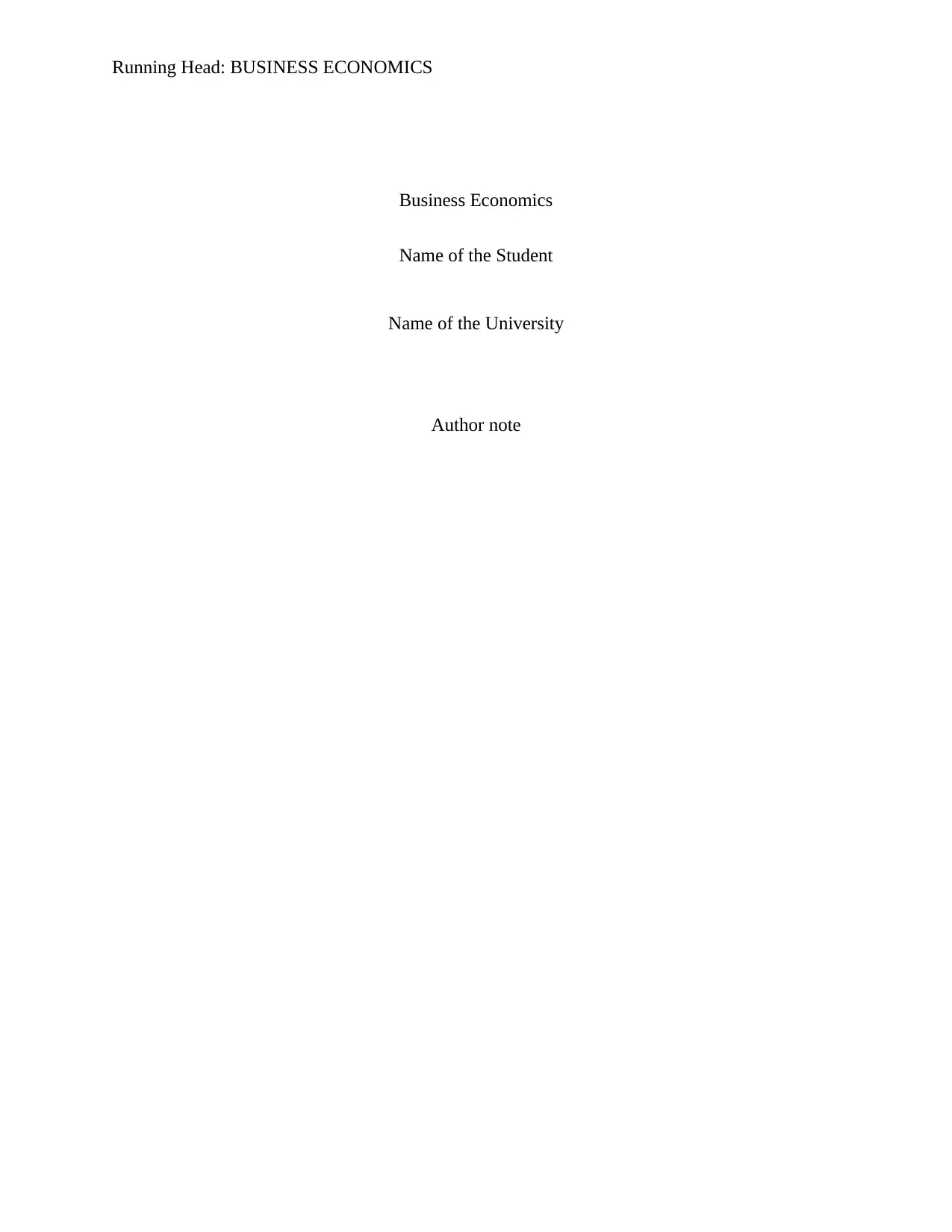
Running Head: BUSINESS ECONOMICS
Business Economics
Name of the Student
Name of the University
Author note
Business Economics
Name of the Student
Name of the University
Author note
Secure Best Marks with AI Grader
Need help grading? Try our AI Grader for instant feedback on your assignments.
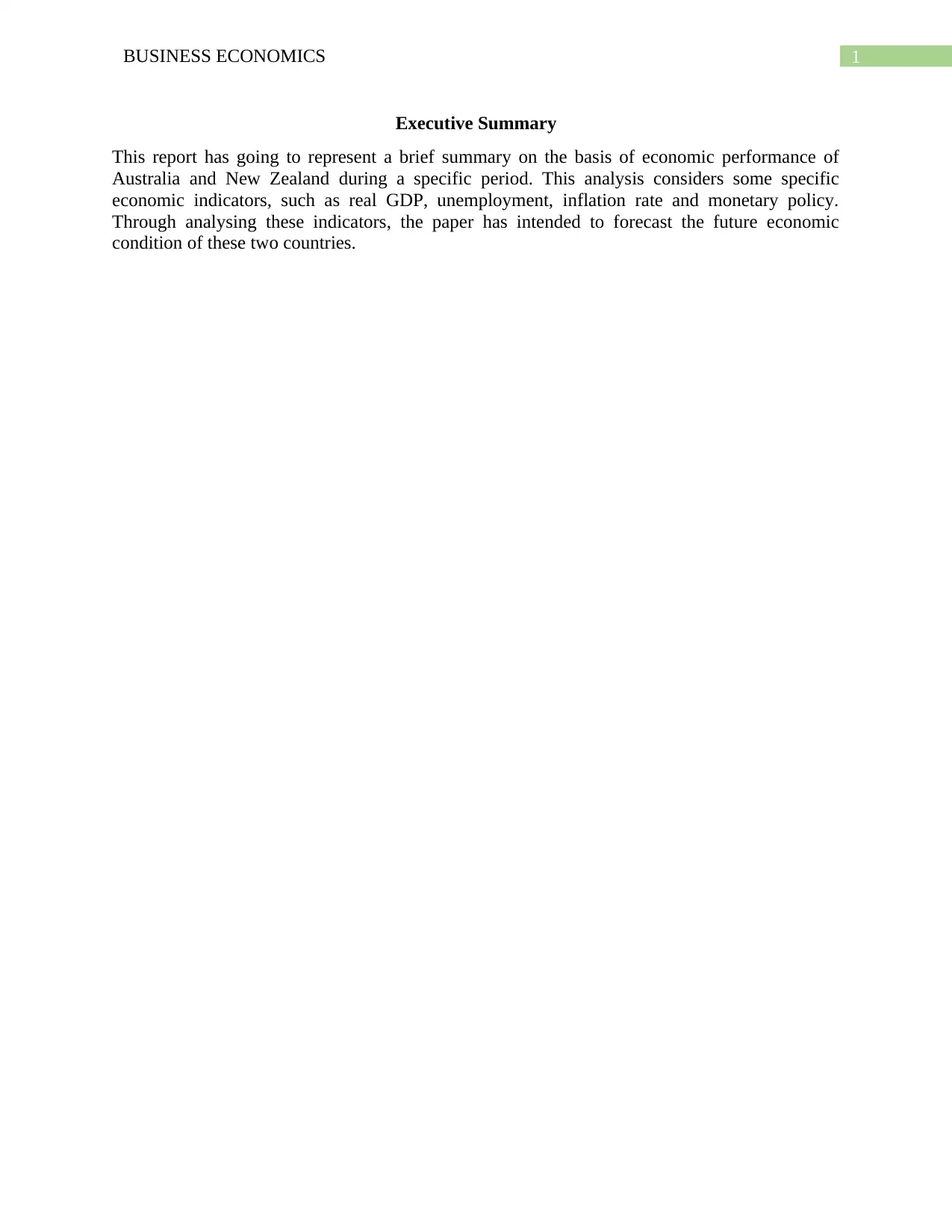
1BUSINESS ECONOMICS
Executive Summary
This report has going to represent a brief summary on the basis of economic performance of
Australia and New Zealand during a specific period. This analysis considers some specific
economic indicators, such as real GDP, unemployment, inflation rate and monetary policy.
Through analysing these indicators, the paper has intended to forecast the future economic
condition of these two countries.
Executive Summary
This report has going to represent a brief summary on the basis of economic performance of
Australia and New Zealand during a specific period. This analysis considers some specific
economic indicators, such as real GDP, unemployment, inflation rate and monetary policy.
Through analysing these indicators, the paper has intended to forecast the future economic
condition of these two countries.
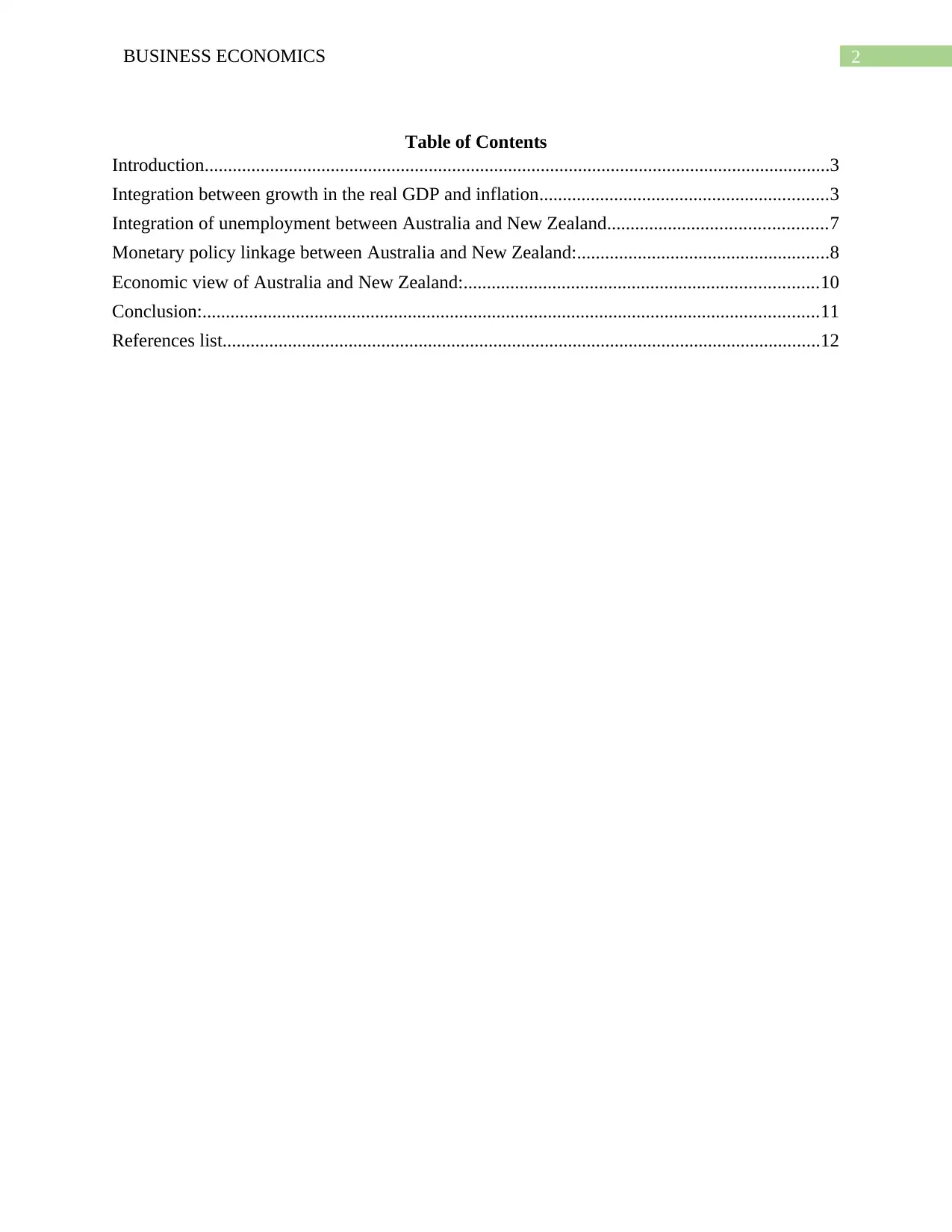
2BUSINESS ECONOMICS
Table of Contents
Introduction......................................................................................................................................3
Integration between growth in the real GDP and inflation..............................................................3
Integration of unemployment between Australia and New Zealand...............................................7
Monetary policy linkage between Australia and New Zealand:......................................................8
Economic view of Australia and New Zealand:............................................................................10
Conclusion:....................................................................................................................................11
References list................................................................................................................................12
Table of Contents
Introduction......................................................................................................................................3
Integration between growth in the real GDP and inflation..............................................................3
Integration of unemployment between Australia and New Zealand...............................................7
Monetary policy linkage between Australia and New Zealand:......................................................8
Economic view of Australia and New Zealand:............................................................................10
Conclusion:....................................................................................................................................11
References list................................................................................................................................12
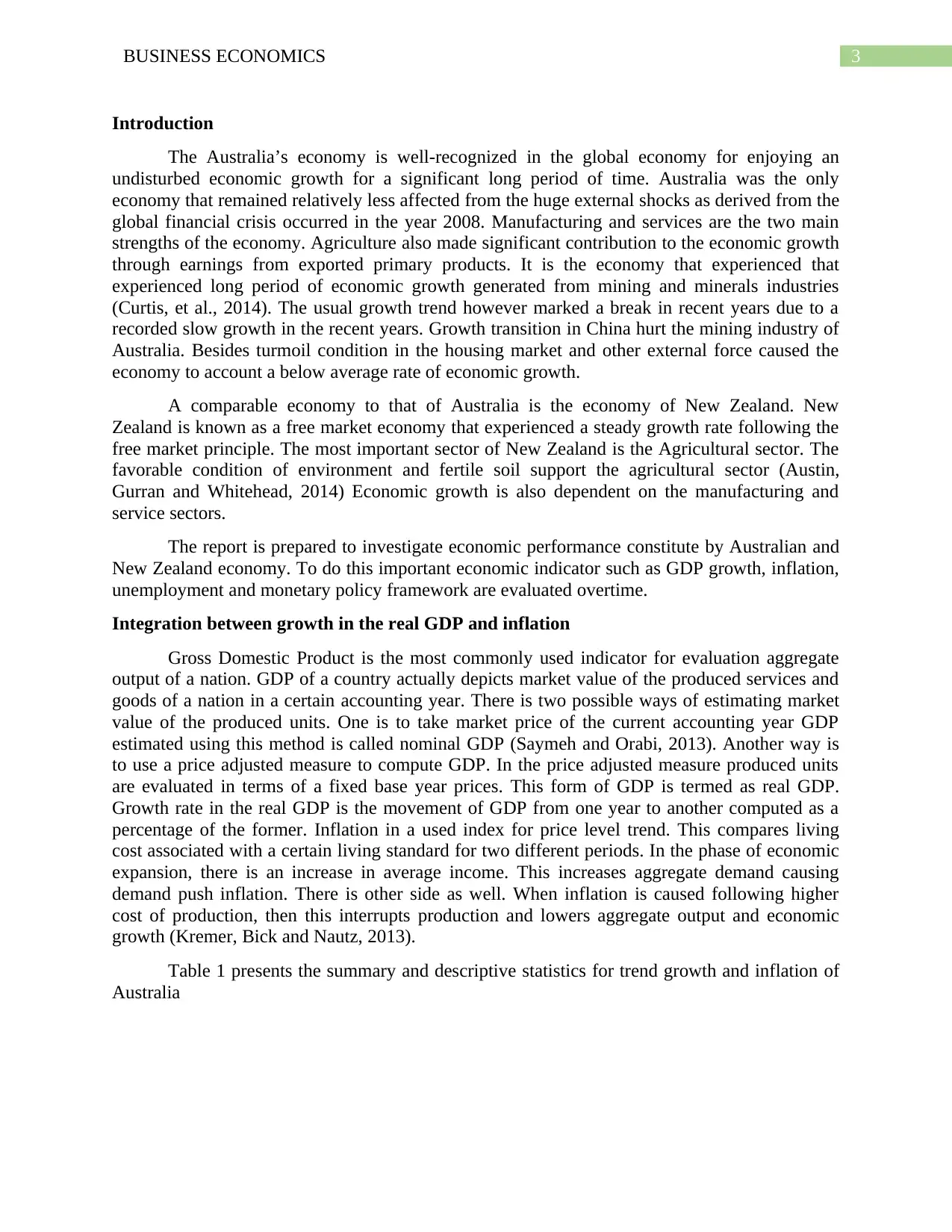
3BUSINESS ECONOMICS
Introduction
The Australia’s economy is well-recognized in the global economy for enjoying an
undisturbed economic growth for a significant long period of time. Australia was the only
economy that remained relatively less affected from the huge external shocks as derived from the
global financial crisis occurred in the year 2008. Manufacturing and services are the two main
strengths of the economy. Agriculture also made significant contribution to the economic growth
through earnings from exported primary products. It is the economy that experienced that
experienced long period of economic growth generated from mining and minerals industries
(Curtis, et al., 2014). The usual growth trend however marked a break in recent years due to a
recorded slow growth in the recent years. Growth transition in China hurt the mining industry of
Australia. Besides turmoil condition in the housing market and other external force caused the
economy to account a below average rate of economic growth.
A comparable economy to that of Australia is the economy of New Zealand. New
Zealand is known as a free market economy that experienced a steady growth rate following the
free market principle. The most important sector of New Zealand is the Agricultural sector. The
favorable condition of environment and fertile soil support the agricultural sector (Austin,
Gurran and Whitehead, 2014) Economic growth is also dependent on the manufacturing and
service sectors.
The report is prepared to investigate economic performance constitute by Australian and
New Zealand economy. To do this important economic indicator such as GDP growth, inflation,
unemployment and monetary policy framework are evaluated overtime.
Integration between growth in the real GDP and inflation
Gross Domestic Product is the most commonly used indicator for evaluation aggregate
output of a nation. GDP of a country actually depicts market value of the produced services and
goods of a nation in a certain accounting year. There is two possible ways of estimating market
value of the produced units. One is to take market price of the current accounting year GDP
estimated using this method is called nominal GDP (Saymeh and Orabi, 2013). Another way is
to use a price adjusted measure to compute GDP. In the price adjusted measure produced units
are evaluated in terms of a fixed base year prices. This form of GDP is termed as real GDP.
Growth rate in the real GDP is the movement of GDP from one year to another computed as a
percentage of the former. Inflation in a used index for price level trend. This compares living
cost associated with a certain living standard for two different periods. In the phase of economic
expansion, there is an increase in average income. This increases aggregate demand causing
demand push inflation. There is other side as well. When inflation is caused following higher
cost of production, then this interrupts production and lowers aggregate output and economic
growth (Kremer, Bick and Nautz, 2013).
Table 1 presents the summary and descriptive statistics for trend growth and inflation of
Australia
Introduction
The Australia’s economy is well-recognized in the global economy for enjoying an
undisturbed economic growth for a significant long period of time. Australia was the only
economy that remained relatively less affected from the huge external shocks as derived from the
global financial crisis occurred in the year 2008. Manufacturing and services are the two main
strengths of the economy. Agriculture also made significant contribution to the economic growth
through earnings from exported primary products. It is the economy that experienced that
experienced long period of economic growth generated from mining and minerals industries
(Curtis, et al., 2014). The usual growth trend however marked a break in recent years due to a
recorded slow growth in the recent years. Growth transition in China hurt the mining industry of
Australia. Besides turmoil condition in the housing market and other external force caused the
economy to account a below average rate of economic growth.
A comparable economy to that of Australia is the economy of New Zealand. New
Zealand is known as a free market economy that experienced a steady growth rate following the
free market principle. The most important sector of New Zealand is the Agricultural sector. The
favorable condition of environment and fertile soil support the agricultural sector (Austin,
Gurran and Whitehead, 2014) Economic growth is also dependent on the manufacturing and
service sectors.
The report is prepared to investigate economic performance constitute by Australian and
New Zealand economy. To do this important economic indicator such as GDP growth, inflation,
unemployment and monetary policy framework are evaluated overtime.
Integration between growth in the real GDP and inflation
Gross Domestic Product is the most commonly used indicator for evaluation aggregate
output of a nation. GDP of a country actually depicts market value of the produced services and
goods of a nation in a certain accounting year. There is two possible ways of estimating market
value of the produced units. One is to take market price of the current accounting year GDP
estimated using this method is called nominal GDP (Saymeh and Orabi, 2013). Another way is
to use a price adjusted measure to compute GDP. In the price adjusted measure produced units
are evaluated in terms of a fixed base year prices. This form of GDP is termed as real GDP.
Growth rate in the real GDP is the movement of GDP from one year to another computed as a
percentage of the former. Inflation in a used index for price level trend. This compares living
cost associated with a certain living standard for two different periods. In the phase of economic
expansion, there is an increase in average income. This increases aggregate demand causing
demand push inflation. There is other side as well. When inflation is caused following higher
cost of production, then this interrupts production and lowers aggregate output and economic
growth (Kremer, Bick and Nautz, 2013).
Table 1 presents the summary and descriptive statistics for trend growth and inflation of
Australia
Secure Best Marks with AI Grader
Need help grading? Try our AI Grader for instant feedback on your assignments.
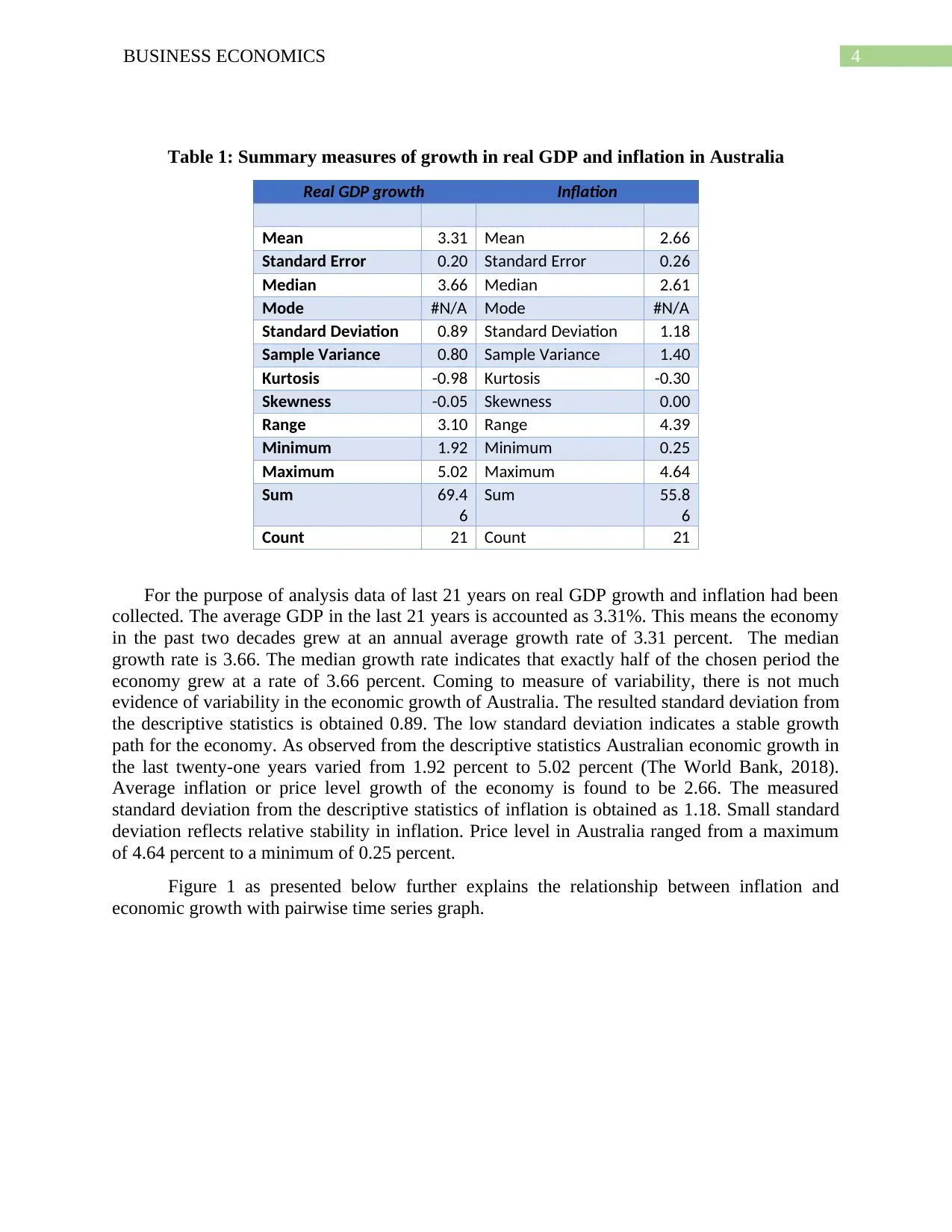
4BUSINESS ECONOMICS
Table 1: Summary measures of growth in real GDP and inflation in Australia
Real GDP growth Inflation
Mean 3.31 Mean 2.66
Standard Error 0.20 Standard Error 0.26
Median 3.66 Median 2.61
Mode #N/A Mode #N/A
Standard Deviation 0.89 Standard Deviation 1.18
Sample Variance 0.80 Sample Variance 1.40
Kurtosis -0.98 Kurtosis -0.30
Skewness -0.05 Skewness 0.00
Range 3.10 Range 4.39
Minimum 1.92 Minimum 0.25
Maximum 5.02 Maximum 4.64
Sum 69.4
6
Sum 55.8
6
Count 21 Count 21
For the purpose of analysis data of last 21 years on real GDP growth and inflation had been
collected. The average GDP in the last 21 years is accounted as 3.31%. This means the economy
in the past two decades grew at an annual average growth rate of 3.31 percent. The median
growth rate is 3.66. The median growth rate indicates that exactly half of the chosen period the
economy grew at a rate of 3.66 percent. Coming to measure of variability, there is not much
evidence of variability in the economic growth of Australia. The resulted standard deviation from
the descriptive statistics is obtained 0.89. The low standard deviation indicates a stable growth
path for the economy. As observed from the descriptive statistics Australian economic growth in
the last twenty-one years varied from 1.92 percent to 5.02 percent (The World Bank, 2018).
Average inflation or price level growth of the economy is found to be 2.66. The measured
standard deviation from the descriptive statistics of inflation is obtained as 1.18. Small standard
deviation reflects relative stability in inflation. Price level in Australia ranged from a maximum
of 4.64 percent to a minimum of 0.25 percent.
Figure 1 as presented below further explains the relationship between inflation and
economic growth with pairwise time series graph.
Table 1: Summary measures of growth in real GDP and inflation in Australia
Real GDP growth Inflation
Mean 3.31 Mean 2.66
Standard Error 0.20 Standard Error 0.26
Median 3.66 Median 2.61
Mode #N/A Mode #N/A
Standard Deviation 0.89 Standard Deviation 1.18
Sample Variance 0.80 Sample Variance 1.40
Kurtosis -0.98 Kurtosis -0.30
Skewness -0.05 Skewness 0.00
Range 3.10 Range 4.39
Minimum 1.92 Minimum 0.25
Maximum 5.02 Maximum 4.64
Sum 69.4
6
Sum 55.8
6
Count 21 Count 21
For the purpose of analysis data of last 21 years on real GDP growth and inflation had been
collected. The average GDP in the last 21 years is accounted as 3.31%. This means the economy
in the past two decades grew at an annual average growth rate of 3.31 percent. The median
growth rate is 3.66. The median growth rate indicates that exactly half of the chosen period the
economy grew at a rate of 3.66 percent. Coming to measure of variability, there is not much
evidence of variability in the economic growth of Australia. The resulted standard deviation from
the descriptive statistics is obtained 0.89. The low standard deviation indicates a stable growth
path for the economy. As observed from the descriptive statistics Australian economic growth in
the last twenty-one years varied from 1.92 percent to 5.02 percent (The World Bank, 2018).
Average inflation or price level growth of the economy is found to be 2.66. The measured
standard deviation from the descriptive statistics of inflation is obtained as 1.18. Small standard
deviation reflects relative stability in inflation. Price level in Australia ranged from a maximum
of 4.64 percent to a minimum of 0.25 percent.
Figure 1 as presented below further explains the relationship between inflation and
economic growth with pairwise time series graph.
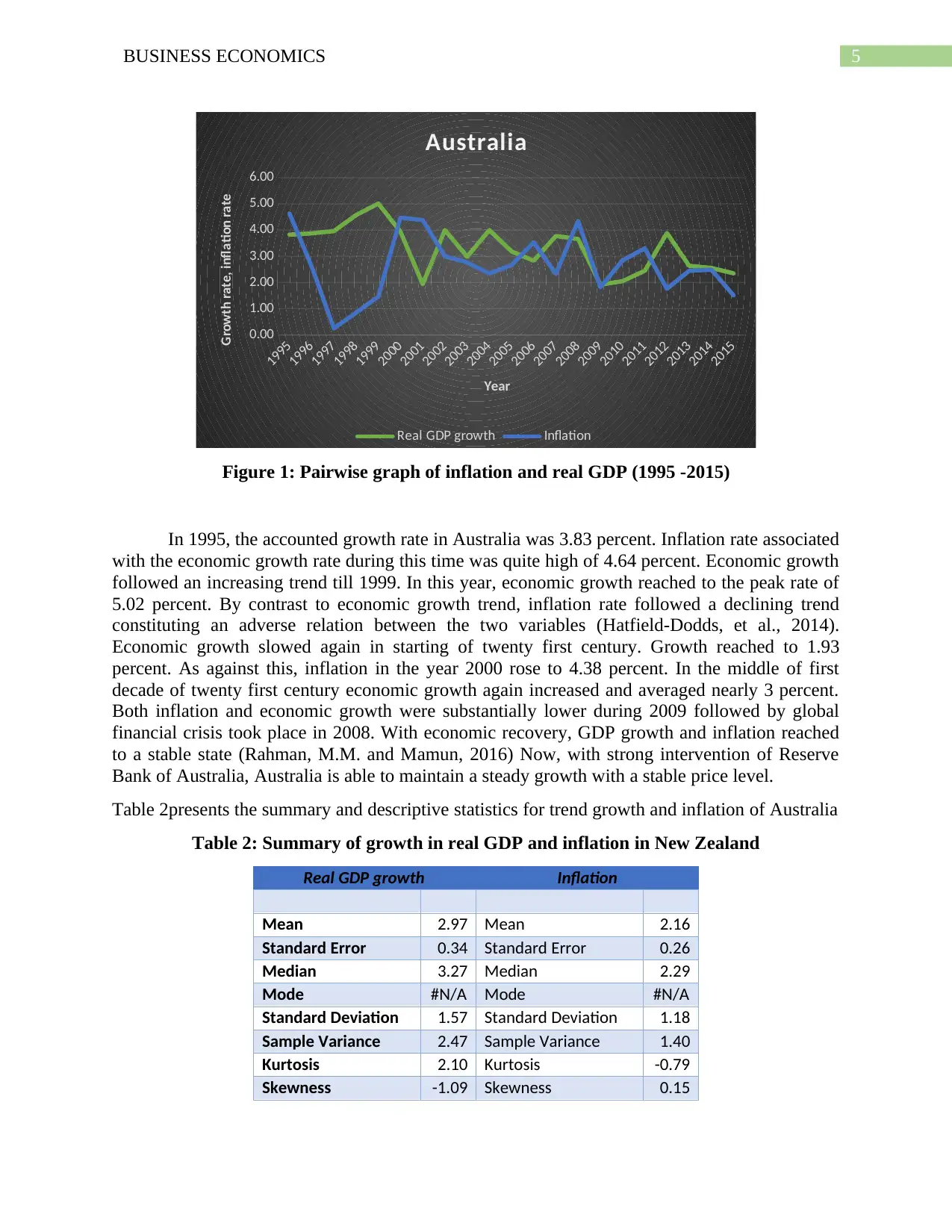
5BUSINESS ECONOMICS
1995
1996
1997
1998
1999
2000
2001
2002
2003
2004
2005
2006
2007
2008
2009
2010
2011
2012
2013
2014
2015
0.00
1.00
2.00
3.00
4.00
5.00
6.00
Australia
Real GDP growth Inflation
Year
Growth rate, inflation rate
Figure 1: Pairwise graph of inflation and real GDP (1995 -2015)
In 1995, the accounted growth rate in Australia was 3.83 percent. Inflation rate associated
with the economic growth rate during this time was quite high of 4.64 percent. Economic growth
followed an increasing trend till 1999. In this year, economic growth reached to the peak rate of
5.02 percent. By contrast to economic growth trend, inflation rate followed a declining trend
constituting an adverse relation between the two variables (Hatfield-Dodds, et al., 2014).
Economic growth slowed again in starting of twenty first century. Growth reached to 1.93
percent. As against this, inflation in the year 2000 rose to 4.38 percent. In the middle of first
decade of twenty first century economic growth again increased and averaged nearly 3 percent.
Both inflation and economic growth were substantially lower during 2009 followed by global
financial crisis took place in 2008. With economic recovery, GDP growth and inflation reached
to a stable state (Rahman, M.M. and Mamun, 2016) Now, with strong intervention of Reserve
Bank of Australia, Australia is able to maintain a steady growth with a stable price level.
Table 2presents the summary and descriptive statistics for trend growth and inflation of Australia
Table 2: Summary of growth in real GDP and inflation in New Zealand
Real GDP growth Inflation
Mean 2.97 Mean 2.16
Standard Error 0.34 Standard Error 0.26
Median 3.27 Median 2.29
Mode #N/A Mode #N/A
Standard Deviation 1.57 Standard Deviation 1.18
Sample Variance 2.47 Sample Variance 1.40
Kurtosis 2.10 Kurtosis -0.79
Skewness -1.09 Skewness 0.15
1995
1996
1997
1998
1999
2000
2001
2002
2003
2004
2005
2006
2007
2008
2009
2010
2011
2012
2013
2014
2015
0.00
1.00
2.00
3.00
4.00
5.00
6.00
Australia
Real GDP growth Inflation
Year
Growth rate, inflation rate
Figure 1: Pairwise graph of inflation and real GDP (1995 -2015)
In 1995, the accounted growth rate in Australia was 3.83 percent. Inflation rate associated
with the economic growth rate during this time was quite high of 4.64 percent. Economic growth
followed an increasing trend till 1999. In this year, economic growth reached to the peak rate of
5.02 percent. By contrast to economic growth trend, inflation rate followed a declining trend
constituting an adverse relation between the two variables (Hatfield-Dodds, et al., 2014).
Economic growth slowed again in starting of twenty first century. Growth reached to 1.93
percent. As against this, inflation in the year 2000 rose to 4.38 percent. In the middle of first
decade of twenty first century economic growth again increased and averaged nearly 3 percent.
Both inflation and economic growth were substantially lower during 2009 followed by global
financial crisis took place in 2008. With economic recovery, GDP growth and inflation reached
to a stable state (Rahman, M.M. and Mamun, 2016) Now, with strong intervention of Reserve
Bank of Australia, Australia is able to maintain a steady growth with a stable price level.
Table 2presents the summary and descriptive statistics for trend growth and inflation of Australia
Table 2: Summary of growth in real GDP and inflation in New Zealand
Real GDP growth Inflation
Mean 2.97 Mean 2.16
Standard Error 0.34 Standard Error 0.26
Median 3.27 Median 2.29
Mode #N/A Mode #N/A
Standard Deviation 1.57 Standard Deviation 1.18
Sample Variance 2.47 Sample Variance 1.40
Kurtosis 2.10 Kurtosis -0.79
Skewness -1.09 Skewness 0.15
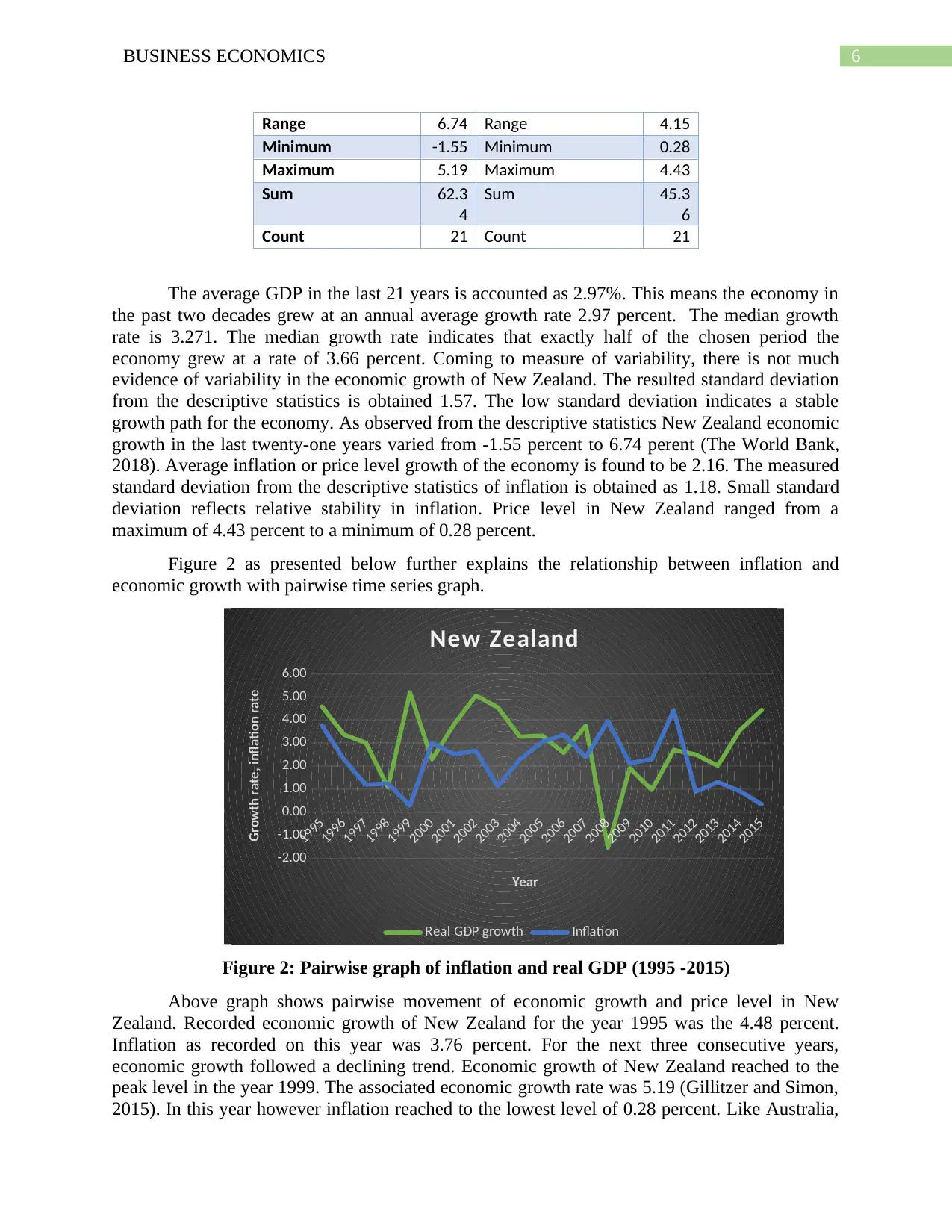
6BUSINESS ECONOMICS
Range 6.74 Range 4.15
Minimum -1.55 Minimum 0.28
Maximum 5.19 Maximum 4.43
Sum 62.3
4
Sum 45.3
6
Count 21 Count 21
The average GDP in the last 21 years is accounted as 2.97%. This means the economy in
the past two decades grew at an annual average growth rate 2.97 percent. The median growth
rate is 3.271. The median growth rate indicates that exactly half of the chosen period the
economy grew at a rate of 3.66 percent. Coming to measure of variability, there is not much
evidence of variability in the economic growth of New Zealand. The resulted standard deviation
from the descriptive statistics is obtained 1.57. The low standard deviation indicates a stable
growth path for the economy. As observed from the descriptive statistics New Zealand economic
growth in the last twenty-one years varied from -1.55 percent to 6.74 perent (The World Bank,
2018). Average inflation or price level growth of the economy is found to be 2.16. The measured
standard deviation from the descriptive statistics of inflation is obtained as 1.18. Small standard
deviation reflects relative stability in inflation. Price level in New Zealand ranged from a
maximum of 4.43 percent to a minimum of 0.28 percent.
Figure 2 as presented below further explains the relationship between inflation and
economic growth with pairwise time series graph.
1995
1996
1997
1998
1999
2000
2001
2002
2003
2004
2005
2006
2007
2008
2009
2010
2011
2012
2013
2014
2015
-2.00
-1.00
0.00
1.00
2.00
3.00
4.00
5.00
6.00
New Zealand
Real GDP growth Inflation
Year
Growth rate, inflation rate
Figure 2: Pairwise graph of inflation and real GDP (1995 -2015)
Above graph shows pairwise movement of economic growth and price level in New
Zealand. Recorded economic growth of New Zealand for the year 1995 was the 4.48 percent.
Inflation as recorded on this year was 3.76 percent. For the next three consecutive years,
economic growth followed a declining trend. Economic growth of New Zealand reached to the
peak level in the year 1999. The associated economic growth rate was 5.19 (Gillitzer and Simon,
2015). In this year however inflation reached to the lowest level of 0.28 percent. Like Australia,
Range 6.74 Range 4.15
Minimum -1.55 Minimum 0.28
Maximum 5.19 Maximum 4.43
Sum 62.3
4
Sum 45.3
6
Count 21 Count 21
The average GDP in the last 21 years is accounted as 2.97%. This means the economy in
the past two decades grew at an annual average growth rate 2.97 percent. The median growth
rate is 3.271. The median growth rate indicates that exactly half of the chosen period the
economy grew at a rate of 3.66 percent. Coming to measure of variability, there is not much
evidence of variability in the economic growth of New Zealand. The resulted standard deviation
from the descriptive statistics is obtained 1.57. The low standard deviation indicates a stable
growth path for the economy. As observed from the descriptive statistics New Zealand economic
growth in the last twenty-one years varied from -1.55 percent to 6.74 perent (The World Bank,
2018). Average inflation or price level growth of the economy is found to be 2.16. The measured
standard deviation from the descriptive statistics of inflation is obtained as 1.18. Small standard
deviation reflects relative stability in inflation. Price level in New Zealand ranged from a
maximum of 4.43 percent to a minimum of 0.28 percent.
Figure 2 as presented below further explains the relationship between inflation and
economic growth with pairwise time series graph.
1995
1996
1997
1998
1999
2000
2001
2002
2003
2004
2005
2006
2007
2008
2009
2010
2011
2012
2013
2014
2015
-2.00
-1.00
0.00
1.00
2.00
3.00
4.00
5.00
6.00
New Zealand
Real GDP growth Inflation
Year
Growth rate, inflation rate
Figure 2: Pairwise graph of inflation and real GDP (1995 -2015)
Above graph shows pairwise movement of economic growth and price level in New
Zealand. Recorded economic growth of New Zealand for the year 1995 was the 4.48 percent.
Inflation as recorded on this year was 3.76 percent. For the next three consecutive years,
economic growth followed a declining trend. Economic growth of New Zealand reached to the
peak level in the year 1999. The associated economic growth rate was 5.19 (Gillitzer and Simon,
2015). In this year however inflation reached to the lowest level of 0.28 percent. Like Australia,
Paraphrase This Document
Need a fresh take? Get an instant paraphrase of this document with our AI Paraphraser
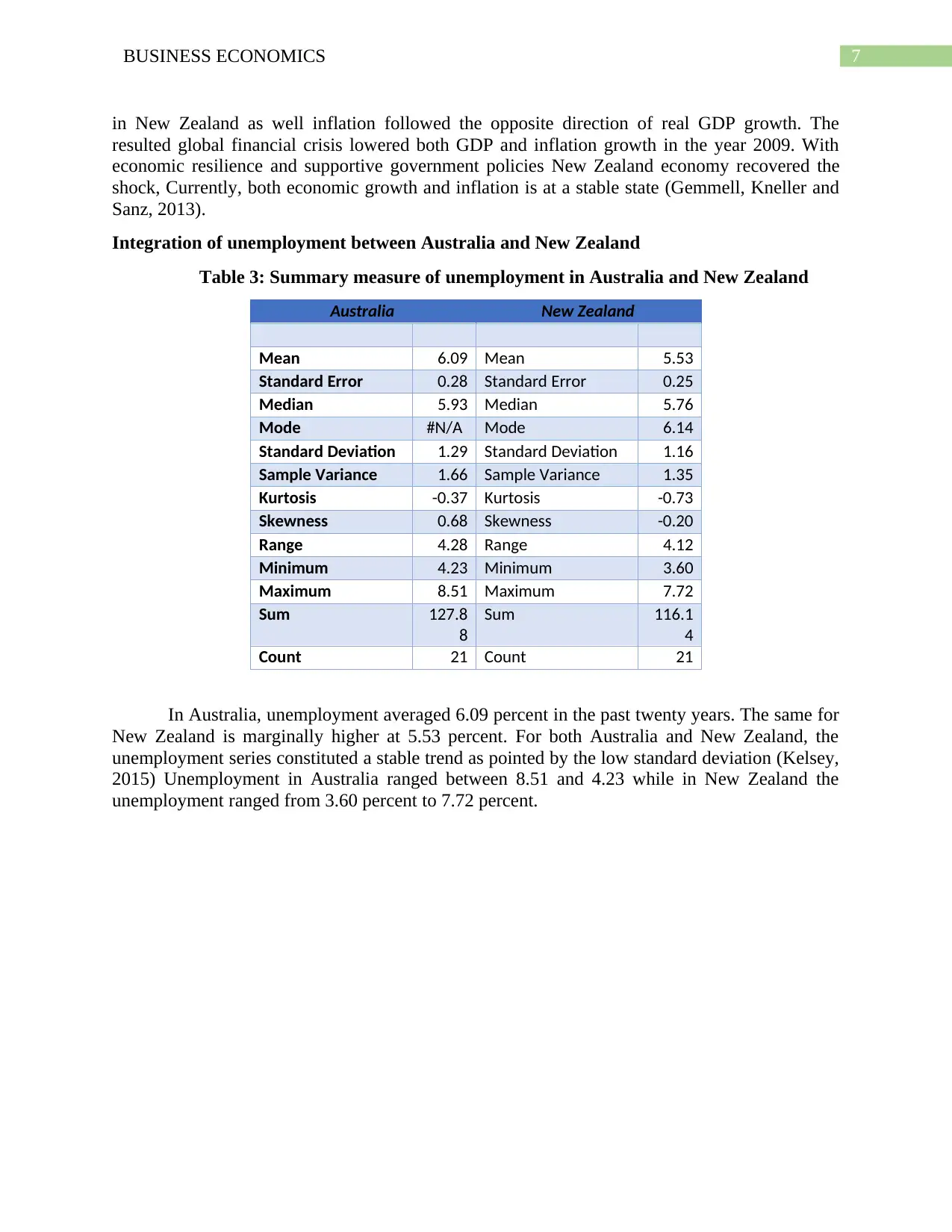
7BUSINESS ECONOMICS
in New Zealand as well inflation followed the opposite direction of real GDP growth. The
resulted global financial crisis lowered both GDP and inflation growth in the year 2009. With
economic resilience and supportive government policies New Zealand economy recovered the
shock, Currently, both economic growth and inflation is at a stable state (Gemmell, Kneller and
Sanz, 2013).
Integration of unemployment between Australia and New Zealand
Table 3: Summary measure of unemployment in Australia and New Zealand
Australia New Zealand
Mean 6.09 Mean 5.53
Standard Error 0.28 Standard Error 0.25
Median 5.93 Median 5.76
Mode #N/A Mode 6.14
Standard Deviation 1.29 Standard Deviation 1.16
Sample Variance 1.66 Sample Variance 1.35
Kurtosis -0.37 Kurtosis -0.73
Skewness 0.68 Skewness -0.20
Range 4.28 Range 4.12
Minimum 4.23 Minimum 3.60
Maximum 8.51 Maximum 7.72
Sum 127.8
8
Sum 116.1
4
Count 21 Count 21
In Australia, unemployment averaged 6.09 percent in the past twenty years. The same for
New Zealand is marginally higher at 5.53 percent. For both Australia and New Zealand, the
unemployment series constituted a stable trend as pointed by the low standard deviation (Kelsey,
2015) Unemployment in Australia ranged between 8.51 and 4.23 while in New Zealand the
unemployment ranged from 3.60 percent to 7.72 percent.
in New Zealand as well inflation followed the opposite direction of real GDP growth. The
resulted global financial crisis lowered both GDP and inflation growth in the year 2009. With
economic resilience and supportive government policies New Zealand economy recovered the
shock, Currently, both economic growth and inflation is at a stable state (Gemmell, Kneller and
Sanz, 2013).
Integration of unemployment between Australia and New Zealand
Table 3: Summary measure of unemployment in Australia and New Zealand
Australia New Zealand
Mean 6.09 Mean 5.53
Standard Error 0.28 Standard Error 0.25
Median 5.93 Median 5.76
Mode #N/A Mode 6.14
Standard Deviation 1.29 Standard Deviation 1.16
Sample Variance 1.66 Sample Variance 1.35
Kurtosis -0.37 Kurtosis -0.73
Skewness 0.68 Skewness -0.20
Range 4.28 Range 4.12
Minimum 4.23 Minimum 3.60
Maximum 8.51 Maximum 7.72
Sum 127.8
8
Sum 116.1
4
Count 21 Count 21
In Australia, unemployment averaged 6.09 percent in the past twenty years. The same for
New Zealand is marginally higher at 5.53 percent. For both Australia and New Zealand, the
unemployment series constituted a stable trend as pointed by the low standard deviation (Kelsey,
2015) Unemployment in Australia ranged between 8.51 and 4.23 while in New Zealand the
unemployment ranged from 3.60 percent to 7.72 percent.
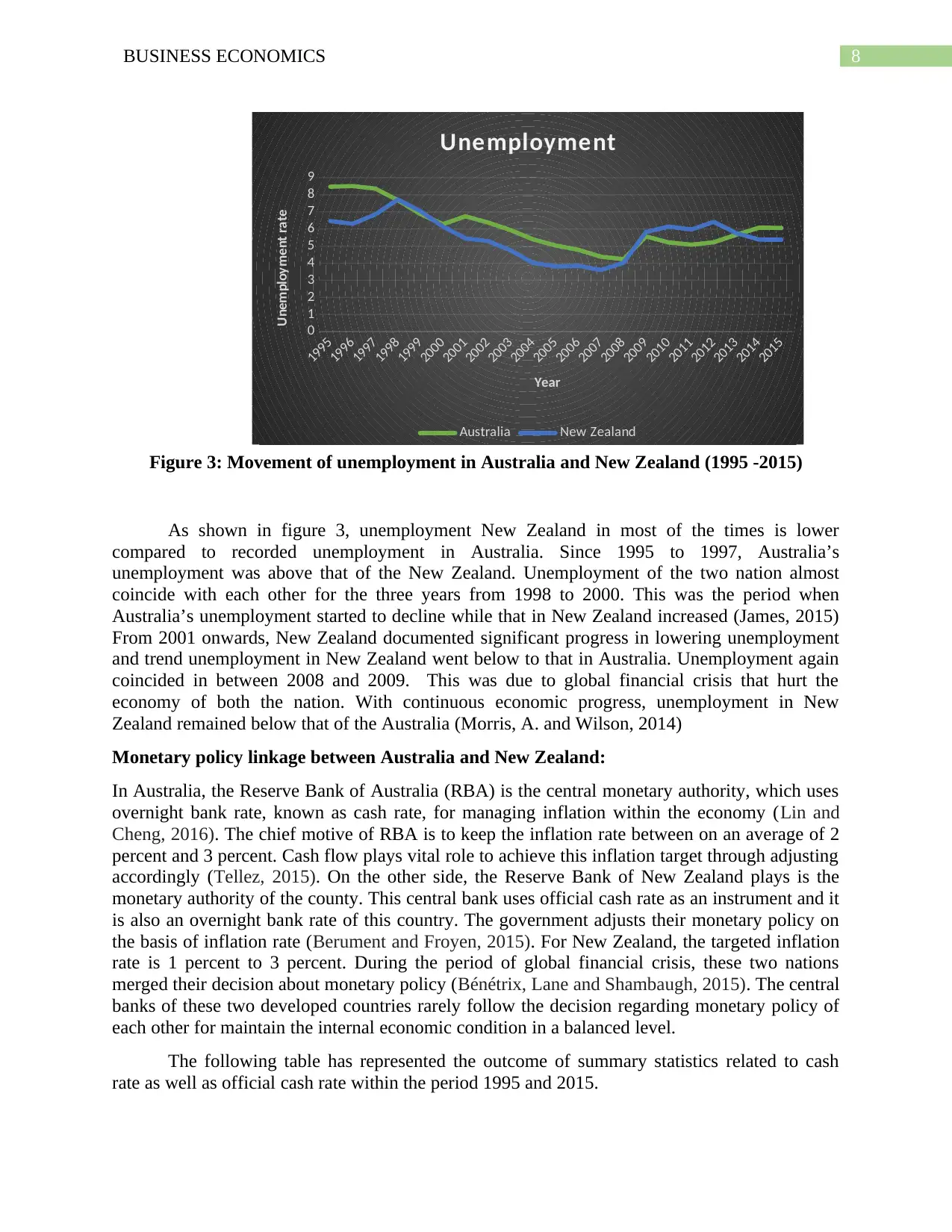
8BUSINESS ECONOMICS
Figure 3: Movement of unemployment in Australia and New Zealand (1995 -2015)
As shown in figure 3, unemployment New Zealand in most of the times is lower
compared to recorded unemployment in Australia. Since 1995 to 1997, Australia’s
unemployment was above that of the New Zealand. Unemployment of the two nation almost
coincide with each other for the three years from 1998 to 2000. This was the period when
Australia’s unemployment started to decline while that in New Zealand increased (James, 2015)
From 2001 onwards, New Zealand documented significant progress in lowering unemployment
and trend unemployment in New Zealand went below to that in Australia. Unemployment again
coincided in between 2008 and 2009. This was due to global financial crisis that hurt the
economy of both the nation. With continuous economic progress, unemployment in New
Zealand remained below that of the Australia (Morris, A. and Wilson, 2014)
Monetary policy linkage between Australia and New Zealand:
In Australia, the Reserve Bank of Australia (RBA) is the central monetary authority, which uses
overnight bank rate, known as cash rate, for managing inflation within the economy (Lin and
Cheng, 2016). The chief motive of RBA is to keep the inflation rate between on an average of 2
percent and 3 percent. Cash flow plays vital role to achieve this inflation target through adjusting
accordingly (Tellez, 2015). On the other side, the Reserve Bank of New Zealand plays is the
monetary authority of the county. This central bank uses official cash rate as an instrument and it
is also an overnight bank rate of this country. The government adjusts their monetary policy on
the basis of inflation rate (Berument and Froyen, 2015). For New Zealand, the targeted inflation
rate is 1 percent to 3 percent. During the period of global financial crisis, these two nations
merged their decision about monetary policy (Bénétrix, Lane and Shambaugh, 2015). The central
banks of these two developed countries rarely follow the decision regarding monetary policy of
each other for maintain the internal economic condition in a balanced level.
The following table has represented the outcome of summary statistics related to cash
rate as well as official cash rate within the period 1995 and 2015.
1995
1996
1997
1998
1999
2000
2001
2002
2003
2004
2005
2006
2007
2008
2009
2010
2011
2012
2013
2014
2015
0
1
2
3
4
5
6
7
8
9
Unemployment
Australia New Zealand
Year
Unemployment rate
Figure 3: Movement of unemployment in Australia and New Zealand (1995 -2015)
As shown in figure 3, unemployment New Zealand in most of the times is lower
compared to recorded unemployment in Australia. Since 1995 to 1997, Australia’s
unemployment was above that of the New Zealand. Unemployment of the two nation almost
coincide with each other for the three years from 1998 to 2000. This was the period when
Australia’s unemployment started to decline while that in New Zealand increased (James, 2015)
From 2001 onwards, New Zealand documented significant progress in lowering unemployment
and trend unemployment in New Zealand went below to that in Australia. Unemployment again
coincided in between 2008 and 2009. This was due to global financial crisis that hurt the
economy of both the nation. With continuous economic progress, unemployment in New
Zealand remained below that of the Australia (Morris, A. and Wilson, 2014)
Monetary policy linkage between Australia and New Zealand:
In Australia, the Reserve Bank of Australia (RBA) is the central monetary authority, which uses
overnight bank rate, known as cash rate, for managing inflation within the economy (Lin and
Cheng, 2016). The chief motive of RBA is to keep the inflation rate between on an average of 2
percent and 3 percent. Cash flow plays vital role to achieve this inflation target through adjusting
accordingly (Tellez, 2015). On the other side, the Reserve Bank of New Zealand plays is the
monetary authority of the county. This central bank uses official cash rate as an instrument and it
is also an overnight bank rate of this country. The government adjusts their monetary policy on
the basis of inflation rate (Berument and Froyen, 2015). For New Zealand, the targeted inflation
rate is 1 percent to 3 percent. During the period of global financial crisis, these two nations
merged their decision about monetary policy (Bénétrix, Lane and Shambaugh, 2015). The central
banks of these two developed countries rarely follow the decision regarding monetary policy of
each other for maintain the internal economic condition in a balanced level.
The following table has represented the outcome of summary statistics related to cash
rate as well as official cash rate within the period 1995 and 2015.
1995
1996
1997
1998
1999
2000
2001
2002
2003
2004
2005
2006
2007
2008
2009
2010
2011
2012
2013
2014
2015
0
1
2
3
4
5
6
7
8
9
Unemployment
Australia New Zealand
Year
Unemployment rate
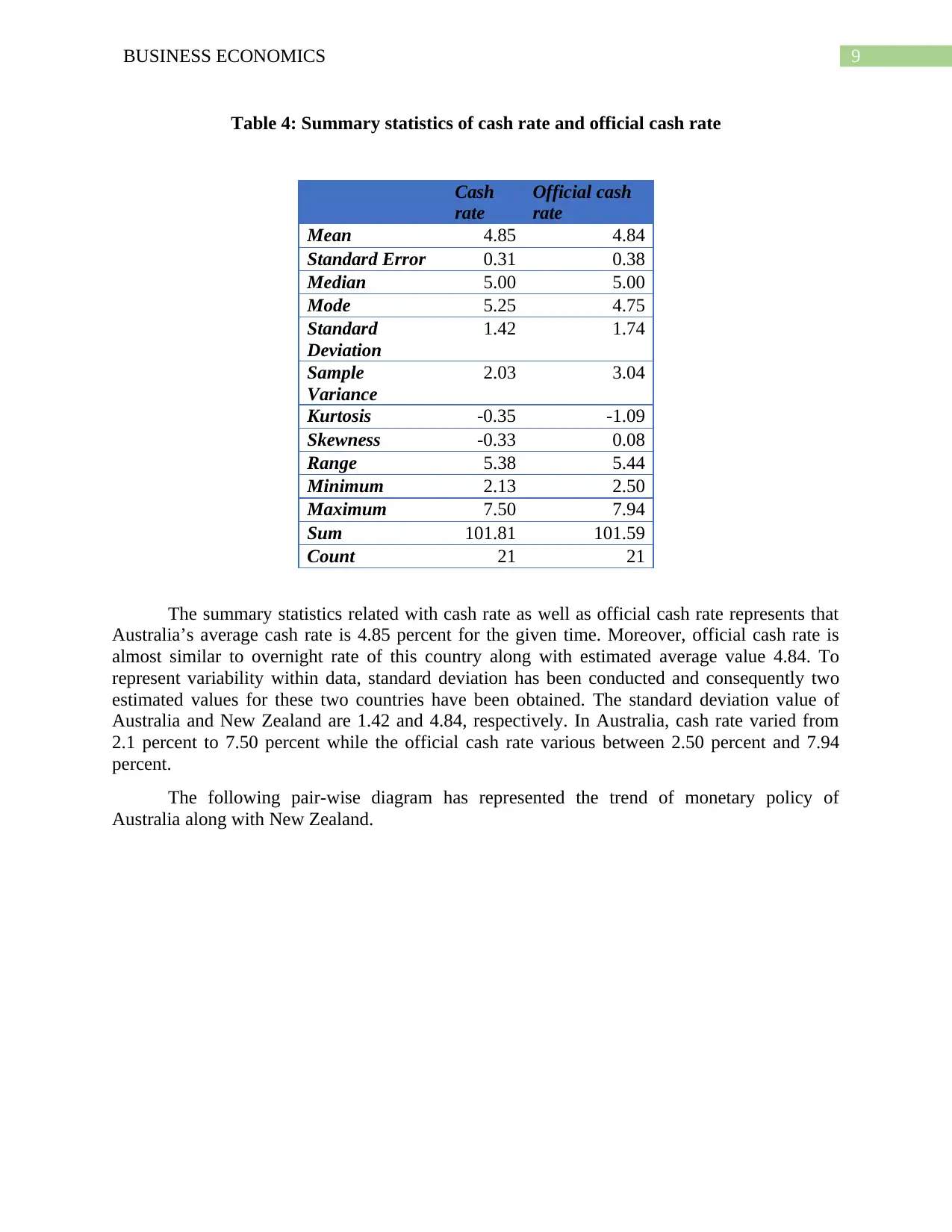
9BUSINESS ECONOMICS
Table 4: Summary statistics of cash rate and official cash rate
Cash
rate
Official cash
rate
Mean 4.85 4.84
Standard Error 0.31 0.38
Median 5.00 5.00
Mode 5.25 4.75
Standard
Deviation
1.42 1.74
Sample
Variance
2.03 3.04
Kurtosis -0.35 -1.09
Skewness -0.33 0.08
Range 5.38 5.44
Minimum 2.13 2.50
Maximum 7.50 7.94
Sum 101.81 101.59
Count 21 21
The summary statistics related with cash rate as well as official cash rate represents that
Australia’s average cash rate is 4.85 percent for the given time. Moreover, official cash rate is
almost similar to overnight rate of this country along with estimated average value 4.84. To
represent variability within data, standard deviation has been conducted and consequently two
estimated values for these two countries have been obtained. The standard deviation value of
Australia and New Zealand are 1.42 and 4.84, respectively. In Australia, cash rate varied from
2.1 percent to 7.50 percent while the official cash rate various between 2.50 percent and 7.94
percent.
The following pair-wise diagram has represented the trend of monetary policy of
Australia along with New Zealand.
Table 4: Summary statistics of cash rate and official cash rate
Cash
rate
Official cash
rate
Mean 4.85 4.84
Standard Error 0.31 0.38
Median 5.00 5.00
Mode 5.25 4.75
Standard
Deviation
1.42 1.74
Sample
Variance
2.03 3.04
Kurtosis -0.35 -1.09
Skewness -0.33 0.08
Range 5.38 5.44
Minimum 2.13 2.50
Maximum 7.50 7.94
Sum 101.81 101.59
Count 21 21
The summary statistics related with cash rate as well as official cash rate represents that
Australia’s average cash rate is 4.85 percent for the given time. Moreover, official cash rate is
almost similar to overnight rate of this country along with estimated average value 4.84. To
represent variability within data, standard deviation has been conducted and consequently two
estimated values for these two countries have been obtained. The standard deviation value of
Australia and New Zealand are 1.42 and 4.84, respectively. In Australia, cash rate varied from
2.1 percent to 7.50 percent while the official cash rate various between 2.50 percent and 7.94
percent.
The following pair-wise diagram has represented the trend of monetary policy of
Australia along with New Zealand.
Secure Best Marks with AI Grader
Need help grading? Try our AI Grader for instant feedback on your assignments.
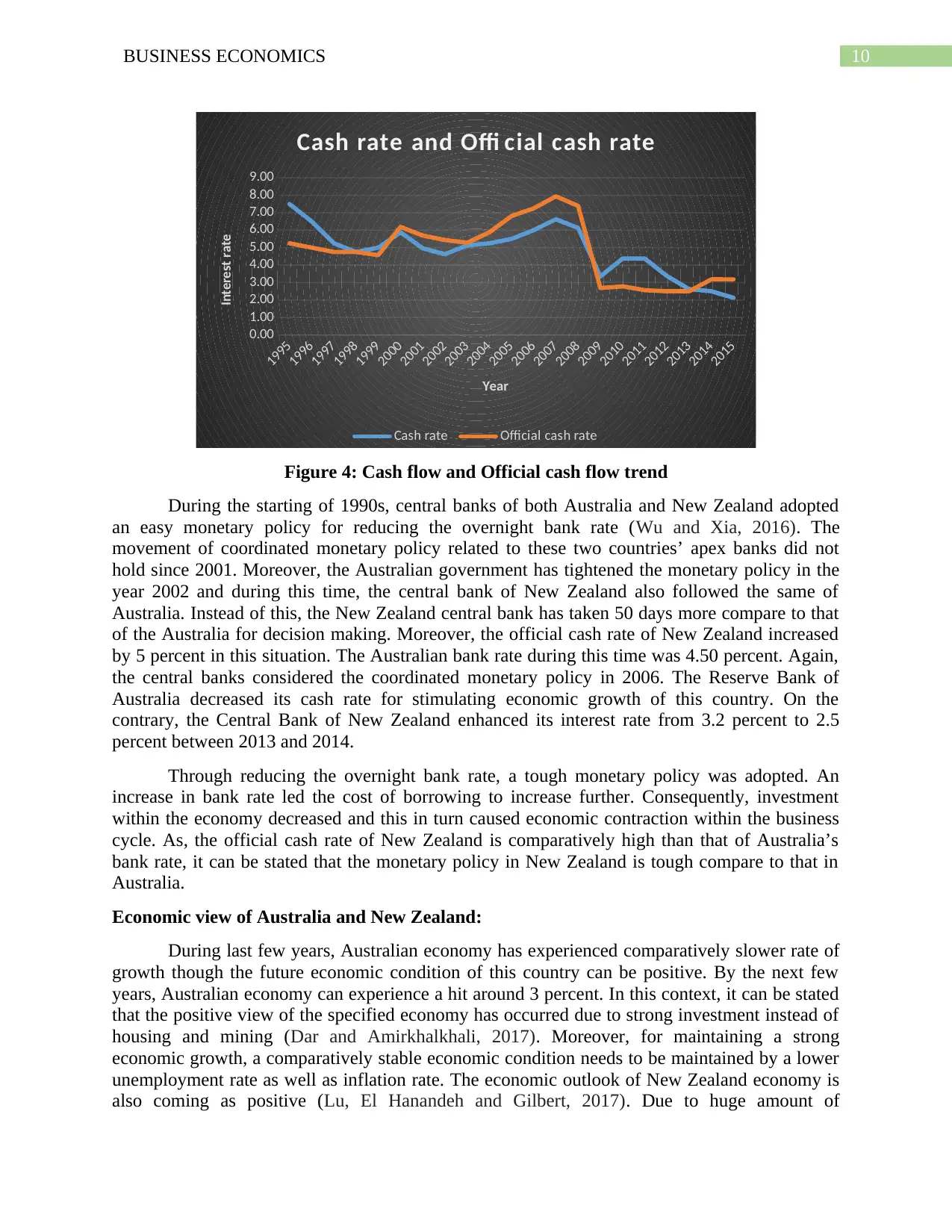
10BUSINESS ECONOMICS
1995
1996
1997
1998
1999
2000
2001
2002
2003
2004
2005
2006
2007
2008
2009
2010
2011
2012
2013
2014
2015
0.00
1.00
2.00
3.00
4.00
5.00
6.00
7.00
8.00
9.00
Cash rate and Offi cial cash rate
Cash rate Official cash rate
Year
Interest rate
Figure 4: Cash flow and Official cash flow trend
During the starting of 1990s, central banks of both Australia and New Zealand adopted
an easy monetary policy for reducing the overnight bank rate (Wu and Xia, 2016). The
movement of coordinated monetary policy related to these two countries’ apex banks did not
hold since 2001. Moreover, the Australian government has tightened the monetary policy in the
year 2002 and during this time, the central bank of New Zealand also followed the same of
Australia. Instead of this, the New Zealand central bank has taken 50 days more compare to that
of the Australia for decision making. Moreover, the official cash rate of New Zealand increased
by 5 percent in this situation. The Australian bank rate during this time was 4.50 percent. Again,
the central banks considered the coordinated monetary policy in 2006. The Reserve Bank of
Australia decreased its cash rate for stimulating economic growth of this country. On the
contrary, the Central Bank of New Zealand enhanced its interest rate from 3.2 percent to 2.5
percent between 2013 and 2014.
Through reducing the overnight bank rate, a tough monetary policy was adopted. An
increase in bank rate led the cost of borrowing to increase further. Consequently, investment
within the economy decreased and this in turn caused economic contraction within the business
cycle. As, the official cash rate of New Zealand is comparatively high than that of Australia’s
bank rate, it can be stated that the monetary policy in New Zealand is tough compare to that in
Australia.
Economic view of Australia and New Zealand:
During last few years, Australian economy has experienced comparatively slower rate of
growth though the future economic condition of this country can be positive. By the next few
years, Australian economy can experience a hit around 3 percent. In this context, it can be stated
that the positive view of the specified economy has occurred due to strong investment instead of
housing and mining (Dar and Amirkhalkhali, 2017). Moreover, for maintaining a strong
economic growth, a comparatively stable economic condition needs to be maintained by a lower
unemployment rate as well as inflation rate. The economic outlook of New Zealand economy is
also coming as positive (Lu, El Hanandeh and Gilbert, 2017). Due to huge amount of
1995
1996
1997
1998
1999
2000
2001
2002
2003
2004
2005
2006
2007
2008
2009
2010
2011
2012
2013
2014
2015
0.00
1.00
2.00
3.00
4.00
5.00
6.00
7.00
8.00
9.00
Cash rate and Offi cial cash rate
Cash rate Official cash rate
Year
Interest rate
Figure 4: Cash flow and Official cash flow trend
During the starting of 1990s, central banks of both Australia and New Zealand adopted
an easy monetary policy for reducing the overnight bank rate (Wu and Xia, 2016). The
movement of coordinated monetary policy related to these two countries’ apex banks did not
hold since 2001. Moreover, the Australian government has tightened the monetary policy in the
year 2002 and during this time, the central bank of New Zealand also followed the same of
Australia. Instead of this, the New Zealand central bank has taken 50 days more compare to that
of the Australia for decision making. Moreover, the official cash rate of New Zealand increased
by 5 percent in this situation. The Australian bank rate during this time was 4.50 percent. Again,
the central banks considered the coordinated monetary policy in 2006. The Reserve Bank of
Australia decreased its cash rate for stimulating economic growth of this country. On the
contrary, the Central Bank of New Zealand enhanced its interest rate from 3.2 percent to 2.5
percent between 2013 and 2014.
Through reducing the overnight bank rate, a tough monetary policy was adopted. An
increase in bank rate led the cost of borrowing to increase further. Consequently, investment
within the economy decreased and this in turn caused economic contraction within the business
cycle. As, the official cash rate of New Zealand is comparatively high than that of Australia’s
bank rate, it can be stated that the monetary policy in New Zealand is tough compare to that in
Australia.
Economic view of Australia and New Zealand:
During last few years, Australian economy has experienced comparatively slower rate of
growth though the future economic condition of this country can be positive. By the next few
years, Australian economy can experience a hit around 3 percent. In this context, it can be stated
that the positive view of the specified economy has occurred due to strong investment instead of
housing and mining (Dar and Amirkhalkhali, 2017). Moreover, for maintaining a strong
economic growth, a comparatively stable economic condition needs to be maintained by a lower
unemployment rate as well as inflation rate. The economic outlook of New Zealand economy is
also coming as positive (Lu, El Hanandeh and Gilbert, 2017). Due to huge amount of
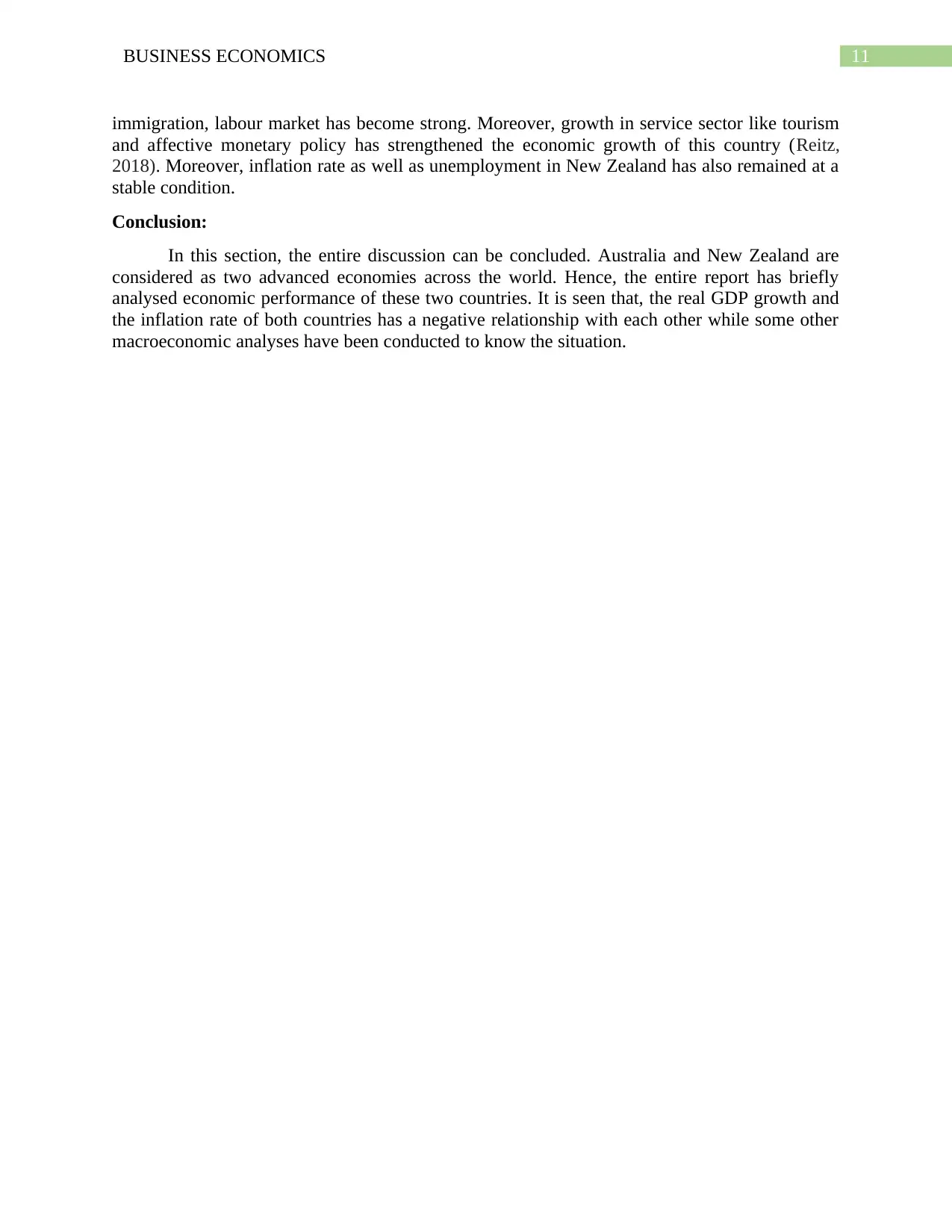
11BUSINESS ECONOMICS
immigration, labour market has become strong. Moreover, growth in service sector like tourism
and affective monetary policy has strengthened the economic growth of this country (Reitz,
2018). Moreover, inflation rate as well as unemployment in New Zealand has also remained at a
stable condition.
Conclusion:
In this section, the entire discussion can be concluded. Australia and New Zealand are
considered as two advanced economies across the world. Hence, the entire report has briefly
analysed economic performance of these two countries. It is seen that, the real GDP growth and
the inflation rate of both countries has a negative relationship with each other while some other
macroeconomic analyses have been conducted to know the situation.
immigration, labour market has become strong. Moreover, growth in service sector like tourism
and affective monetary policy has strengthened the economic growth of this country (Reitz,
2018). Moreover, inflation rate as well as unemployment in New Zealand has also remained at a
stable condition.
Conclusion:
In this section, the entire discussion can be concluded. Australia and New Zealand are
considered as two advanced economies across the world. Hence, the entire report has briefly
analysed economic performance of these two countries. It is seen that, the real GDP growth and
the inflation rate of both countries has a negative relationship with each other while some other
macroeconomic analyses have been conducted to know the situation.
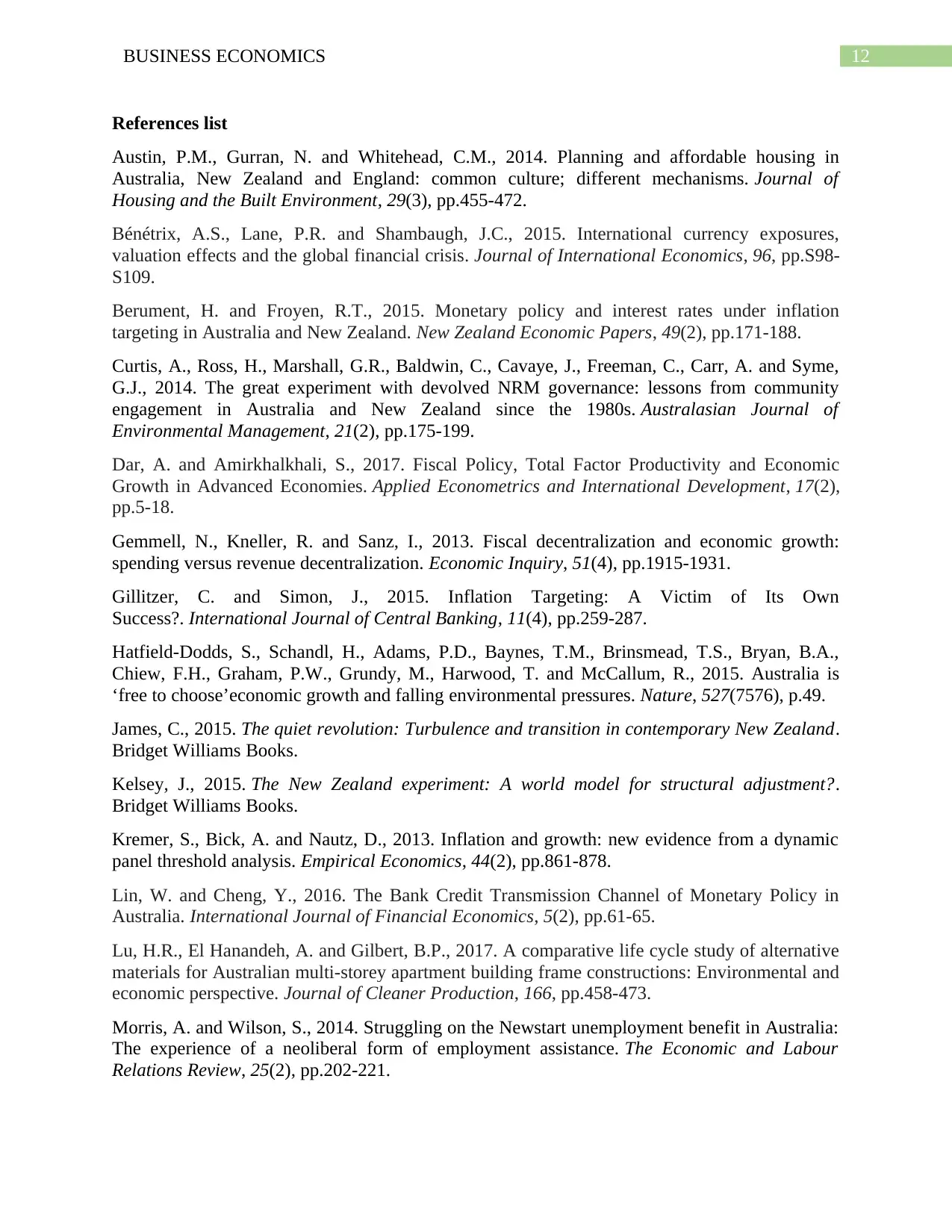
12BUSINESS ECONOMICS
References list
Austin, P.M., Gurran, N. and Whitehead, C.M., 2014. Planning and affordable housing in
Australia, New Zealand and England: common culture; different mechanisms. Journal of
Housing and the Built Environment, 29(3), pp.455-472.
Bénétrix, A.S., Lane, P.R. and Shambaugh, J.C., 2015. International currency exposures,
valuation effects and the global financial crisis. Journal of International Economics, 96, pp.S98-
S109.
Berument, H. and Froyen, R.T., 2015. Monetary policy and interest rates under inflation
targeting in Australia and New Zealand. New Zealand Economic Papers, 49(2), pp.171-188.
Curtis, A., Ross, H., Marshall, G.R., Baldwin, C., Cavaye, J., Freeman, C., Carr, A. and Syme,
G.J., 2014. The great experiment with devolved NRM governance: lessons from community
engagement in Australia and New Zealand since the 1980s. Australasian Journal of
Environmental Management, 21(2), pp.175-199.
Dar, A. and Amirkhalkhali, S., 2017. Fiscal Policy, Total Factor Productivity and Economic
Growth in Advanced Economies. Applied Econometrics and International Development, 17(2),
pp.5-18.
Gemmell, N., Kneller, R. and Sanz, I., 2013. Fiscal decentralization and economic growth:
spending versus revenue decentralization. Economic Inquiry, 51(4), pp.1915-1931.
Gillitzer, C. and Simon, J., 2015. Inflation Targeting: A Victim of Its Own
Success?. International Journal of Central Banking, 11(4), pp.259-287.
Hatfield-Dodds, S., Schandl, H., Adams, P.D., Baynes, T.M., Brinsmead, T.S., Bryan, B.A.,
Chiew, F.H., Graham, P.W., Grundy, M., Harwood, T. and McCallum, R., 2015. Australia is
‘free to choose’economic growth and falling environmental pressures. Nature, 527(7576), p.49.
James, C., 2015. The quiet revolution: Turbulence and transition in contemporary New Zealand.
Bridget Williams Books.
Kelsey, J., 2015. The New Zealand experiment: A world model for structural adjustment?.
Bridget Williams Books.
Kremer, S., Bick, A. and Nautz, D., 2013. Inflation and growth: new evidence from a dynamic
panel threshold analysis. Empirical Economics, 44(2), pp.861-878.
Lin, W. and Cheng, Y., 2016. The Bank Credit Transmission Channel of Monetary Policy in
Australia. International Journal of Financial Economics, 5(2), pp.61-65.
Lu, H.R., El Hanandeh, A. and Gilbert, B.P., 2017. A comparative life cycle study of alternative
materials for Australian multi-storey apartment building frame constructions: Environmental and
economic perspective. Journal of Cleaner Production, 166, pp.458-473.
Morris, A. and Wilson, S., 2014. Struggling on the Newstart unemployment benefit in Australia:
The experience of a neoliberal form of employment assistance. The Economic and Labour
Relations Review, 25(2), pp.202-221.
References list
Austin, P.M., Gurran, N. and Whitehead, C.M., 2014. Planning and affordable housing in
Australia, New Zealand and England: common culture; different mechanisms. Journal of
Housing and the Built Environment, 29(3), pp.455-472.
Bénétrix, A.S., Lane, P.R. and Shambaugh, J.C., 2015. International currency exposures,
valuation effects and the global financial crisis. Journal of International Economics, 96, pp.S98-
S109.
Berument, H. and Froyen, R.T., 2015. Monetary policy and interest rates under inflation
targeting in Australia and New Zealand. New Zealand Economic Papers, 49(2), pp.171-188.
Curtis, A., Ross, H., Marshall, G.R., Baldwin, C., Cavaye, J., Freeman, C., Carr, A. and Syme,
G.J., 2014. The great experiment with devolved NRM governance: lessons from community
engagement in Australia and New Zealand since the 1980s. Australasian Journal of
Environmental Management, 21(2), pp.175-199.
Dar, A. and Amirkhalkhali, S., 2017. Fiscal Policy, Total Factor Productivity and Economic
Growth in Advanced Economies. Applied Econometrics and International Development, 17(2),
pp.5-18.
Gemmell, N., Kneller, R. and Sanz, I., 2013. Fiscal decentralization and economic growth:
spending versus revenue decentralization. Economic Inquiry, 51(4), pp.1915-1931.
Gillitzer, C. and Simon, J., 2015. Inflation Targeting: A Victim of Its Own
Success?. International Journal of Central Banking, 11(4), pp.259-287.
Hatfield-Dodds, S., Schandl, H., Adams, P.D., Baynes, T.M., Brinsmead, T.S., Bryan, B.A.,
Chiew, F.H., Graham, P.W., Grundy, M., Harwood, T. and McCallum, R., 2015. Australia is
‘free to choose’economic growth and falling environmental pressures. Nature, 527(7576), p.49.
James, C., 2015. The quiet revolution: Turbulence and transition in contemporary New Zealand.
Bridget Williams Books.
Kelsey, J., 2015. The New Zealand experiment: A world model for structural adjustment?.
Bridget Williams Books.
Kremer, S., Bick, A. and Nautz, D., 2013. Inflation and growth: new evidence from a dynamic
panel threshold analysis. Empirical Economics, 44(2), pp.861-878.
Lin, W. and Cheng, Y., 2016. The Bank Credit Transmission Channel of Monetary Policy in
Australia. International Journal of Financial Economics, 5(2), pp.61-65.
Lu, H.R., El Hanandeh, A. and Gilbert, B.P., 2017. A comparative life cycle study of alternative
materials for Australian multi-storey apartment building frame constructions: Environmental and
economic perspective. Journal of Cleaner Production, 166, pp.458-473.
Morris, A. and Wilson, S., 2014. Struggling on the Newstart unemployment benefit in Australia:
The experience of a neoliberal form of employment assistance. The Economic and Labour
Relations Review, 25(2), pp.202-221.
Paraphrase This Document
Need a fresh take? Get an instant paraphrase of this document with our AI Paraphraser
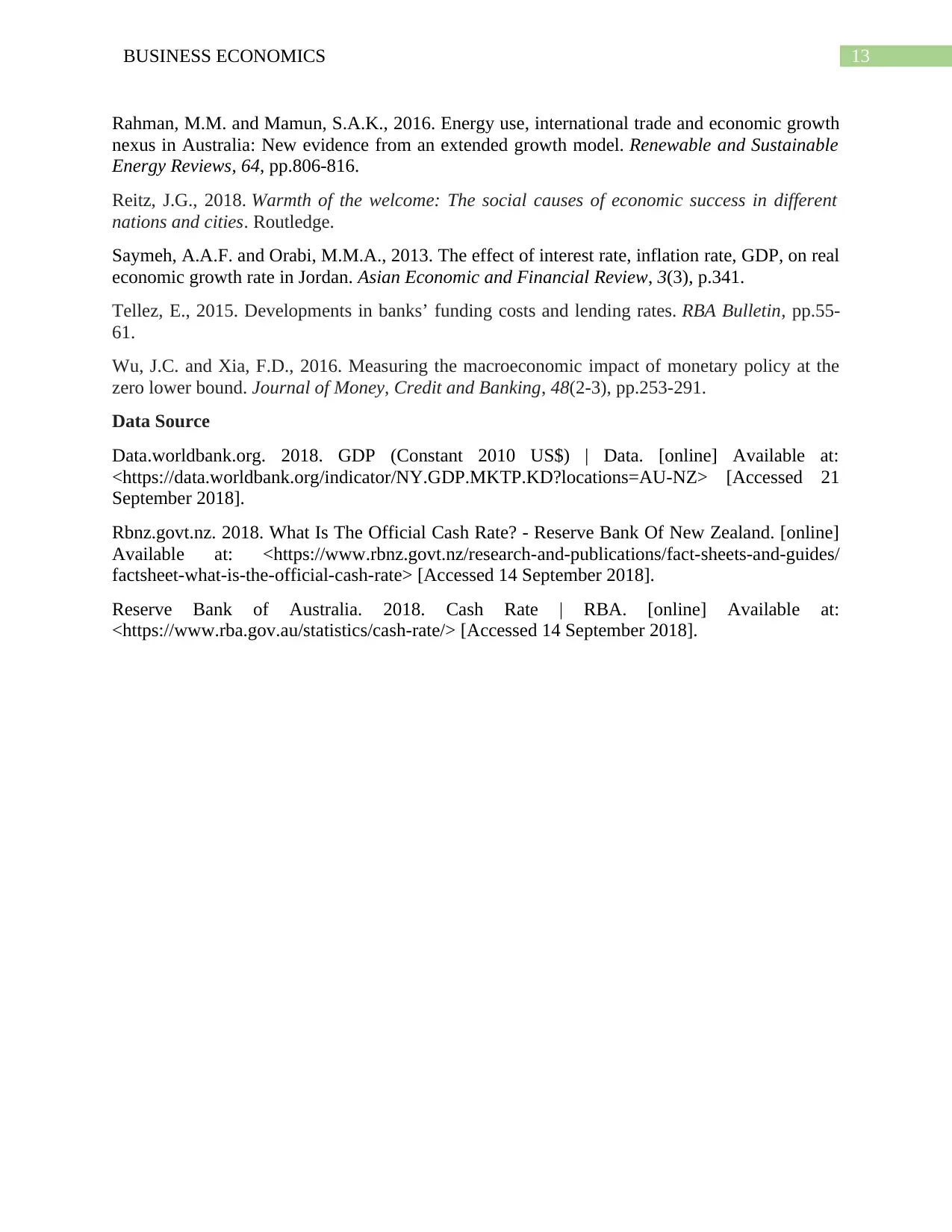
13BUSINESS ECONOMICS
Rahman, M.M. and Mamun, S.A.K., 2016. Energy use, international trade and economic growth
nexus in Australia: New evidence from an extended growth model. Renewable and Sustainable
Energy Reviews, 64, pp.806-816.
Reitz, J.G., 2018. Warmth of the welcome: The social causes of economic success in different
nations and cities. Routledge.
Saymeh, A.A.F. and Orabi, M.M.A., 2013. The effect of interest rate, inflation rate, GDP, on real
economic growth rate in Jordan. Asian Economic and Financial Review, 3(3), p.341.
Tellez, E., 2015. Developments in banks’ funding costs and lending rates. RBA Bulletin, pp.55-
61.
Wu, J.C. and Xia, F.D., 2016. Measuring the macroeconomic impact of monetary policy at the
zero lower bound. Journal of Money, Credit and Banking, 48(2-3), pp.253-291.
Data Source
Data.worldbank.org. 2018. GDP (Constant 2010 US$) | Data. [online] Available at:
<https://data.worldbank.org/indicator/NY.GDP.MKTP.KD?locations=AU-NZ> [Accessed 21
September 2018].
Rbnz.govt.nz. 2018. What Is The Official Cash Rate? - Reserve Bank Of New Zealand. [online]
Available at: <https://www.rbnz.govt.nz/research-and-publications/fact-sheets-and-guides/
factsheet-what-is-the-official-cash-rate> [Accessed 14 September 2018].
Reserve Bank of Australia. 2018. Cash Rate | RBA. [online] Available at:
<https://www.rba.gov.au/statistics/cash-rate/> [Accessed 14 September 2018].
Rahman, M.M. and Mamun, S.A.K., 2016. Energy use, international trade and economic growth
nexus in Australia: New evidence from an extended growth model. Renewable and Sustainable
Energy Reviews, 64, pp.806-816.
Reitz, J.G., 2018. Warmth of the welcome: The social causes of economic success in different
nations and cities. Routledge.
Saymeh, A.A.F. and Orabi, M.M.A., 2013. The effect of interest rate, inflation rate, GDP, on real
economic growth rate in Jordan. Asian Economic and Financial Review, 3(3), p.341.
Tellez, E., 2015. Developments in banks’ funding costs and lending rates. RBA Bulletin, pp.55-
61.
Wu, J.C. and Xia, F.D., 2016. Measuring the macroeconomic impact of monetary policy at the
zero lower bound. Journal of Money, Credit and Banking, 48(2-3), pp.253-291.
Data Source
Data.worldbank.org. 2018. GDP (Constant 2010 US$) | Data. [online] Available at:
<https://data.worldbank.org/indicator/NY.GDP.MKTP.KD?locations=AU-NZ> [Accessed 21
September 2018].
Rbnz.govt.nz. 2018. What Is The Official Cash Rate? - Reserve Bank Of New Zealand. [online]
Available at: <https://www.rbnz.govt.nz/research-and-publications/fact-sheets-and-guides/
factsheet-what-is-the-official-cash-rate> [Accessed 14 September 2018].
Reserve Bank of Australia. 2018. Cash Rate | RBA. [online] Available at:
<https://www.rba.gov.au/statistics/cash-rate/> [Accessed 14 September 2018].
1 out of 14
Related Documents
Your All-in-One AI-Powered Toolkit for Academic Success.
+13062052269
info@desklib.com
Available 24*7 on WhatsApp / Email
![[object Object]](/_next/static/media/star-bottom.7253800d.svg)
Unlock your academic potential
© 2024 | Zucol Services PVT LTD | All rights reserved.





